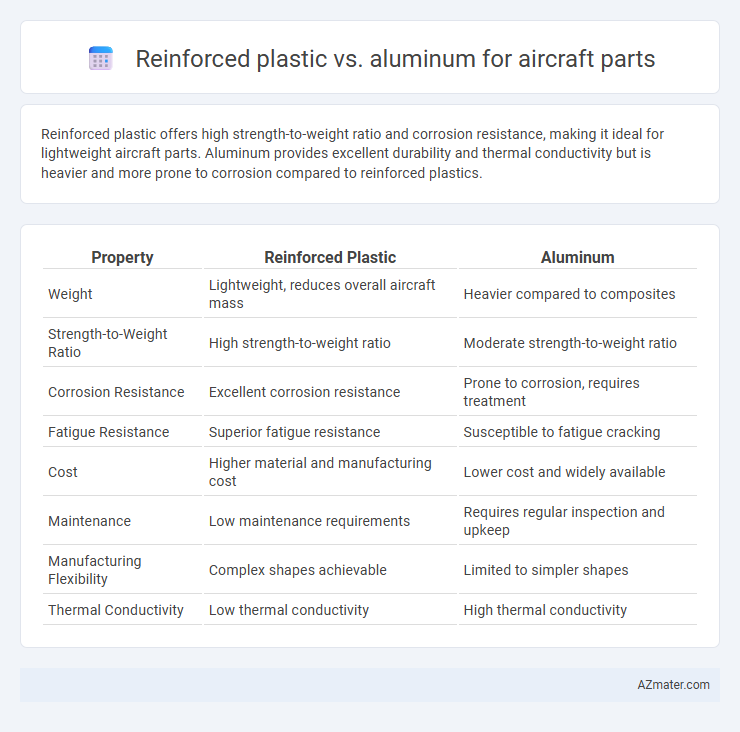Reinforced plastic offers high strength-to-weight ratio and corrosion resistance, making it ideal for lightweight aircraft parts. Aluminum provides excellent durability and thermal conductivity but is heavier and more prone to corrosion compared to reinforced plastics.
Table of Comparison
| Property | Reinforced Plastic | Aluminum |
|---|---|---|
| Weight | Lightweight, reduces overall aircraft mass | Heavier compared to composites |
| Strength-to-Weight Ratio | High strength-to-weight ratio | Moderate strength-to-weight ratio |
| Corrosion Resistance | Excellent corrosion resistance | Prone to corrosion, requires treatment |
| Fatigue Resistance | Superior fatigue resistance | Susceptible to fatigue cracking |
| Cost | Higher material and manufacturing cost | Lower cost and widely available |
| Maintenance | Low maintenance requirements | Requires regular inspection and upkeep |
| Manufacturing Flexibility | Complex shapes achievable | Limited to simpler shapes |
| Thermal Conductivity | Low thermal conductivity | High thermal conductivity |
Introduction to Aircraft Material Selection
Aircraft material selection hinges on balancing strength, weight, and durability, where reinforced plastics offer high strength-to-weight ratios, corrosion resistance, and fatigue tolerance compared to aluminum. Reinforced plastics, including composites like carbon fiber-reinforced polymers, provide enhanced design flexibility and improved fuel efficiency by reducing overall aircraft weight. Aluminum remains widely used due to its proven structural integrity, ease of fabrication, and cost-effectiveness, but modern aircraft increasingly integrate reinforced plastics for critical components to optimize performance and longevity.
Overview of Reinforced Plastics in Aviation
Reinforced plastics, particularly carbon fiber-reinforced polymers (CFRP), offer exceptional strength-to-weight ratios and corrosion resistance, making them ideal for aircraft structures such as fuselage panels and wing components. These composites provide enhanced fatigue performance and damage tolerance compared to traditional metal alloys like aluminum, contributing to improved fuel efficiency and reduced maintenance costs. Advances in manufacturing techniques, including automated fiber placement, continue to expand the application of reinforced plastics in modern aviation designs.
Aluminum: The Traditional Choice for Aircraft
Aluminum remains the traditional choice for aircraft parts due to its exceptional strength-to-weight ratio, corrosion resistance, and ease of fabrication. Its high fatigue resistance ensures durability over repeated stress cycles, making it ideal for structural components such as wings and fuselage frames. Despite the rise of reinforced plastics, aluminum's established performance in aerospace applications continues to support its widespread use.
Mechanical Strength Comparison
Reinforced plastic composites offer superior strength-to-weight ratios compared to aluminum, making them ideal for aircraft parts requiring high mechanical performance with reduced mass. Although aluminum provides excellent tensile strength and durability, reinforced plastics exhibit greater resistance to fatigue and corrosion while maintaining comparable stiffness. Advanced fiber-reinforced polymers achieve tensile strengths exceeding 1,000 MPa, surpassing common aluminum alloys like 7075-T6, which typically have tensile strengths around 570 MPa.
Weight and Fuel Efficiency Impact
Reinforced plastic composites offer significant weight reduction compared to aluminum, typically up to 30-50% lighter, directly enhancing aircraft fuel efficiency by lowering overall mass and drag. The reduced weight leads to decreased fuel consumption, enabling longer flight ranges and lower emissions per mile. Aluminum, while durable and corrosion-resistant, tends to increase structural weight, which can adversely impact fuel efficiency in comparison to advanced composite materials.
Corrosion Resistance and Longevity
Reinforced plastics exhibit superior corrosion resistance compared to aluminum, as they are not susceptible to oxidation or galvanic corrosion common in metal alloys used in aircraft parts. Aluminum offers high strength-to-weight ratio but requires protective coatings and regular maintenance to prevent corrosion, especially in harsh environments. The longevity of reinforced plastics in aircraft components often surpasses aluminum due to their inherent resistance to environmental degradation, reducing lifecycle costs and extending service intervals.
Manufacturing and Cost Considerations
Reinforced plastics offer significant weight savings and corrosion resistance in aircraft manufacturing, reducing fuel consumption and maintenance costs compared to aluminum. Manufacturing processes for reinforced plastics, such as resin transfer molding and automated fiber placement, enable complex geometries but often require higher initial capital investment and longer cycle times than traditional aluminum forming techniques. While aluminum benefits from established supply chains and lower material costs, reinforced plastics typically reduce overall lifecycle expenses through improved durability and performance efficiencies.
Maintenance and Repair Differences
Reinforced plastic components in aircraft require specialized repair techniques such as resin injection and curing processes, often performed in controlled environments to maintain material integrity. Aluminum parts benefit from widespread industry familiarity, allowing for quicker, cost-effective maintenance through conventional methods like machining, welding, and corrosion removal. However, aluminum's susceptibility to corrosion demands regular inspections, while reinforced plastics are more resistant to environmental degradation but may necessitate complex damage assessments using advanced nondestructive testing.
Safety and Regulatory Standards
Reinforced plastic composites exhibit superior corrosion resistance and energy absorption, enhancing crashworthiness in aircraft parts while meeting stringent FAA and EASA safety regulations. Aluminum alloys, traditionally favored for their high strength-to-weight ratio, comply with well-established certification protocols but face challenges like fatigue and corrosion that require regular inspections. Compliance with updated aviation standards mandates rigorous testing for both materials to ensure structural integrity, fire resistance, and impact tolerance in critical aircraft components.
Future Trends in Aircraft Material Innovation
Reinforced plastics offer significant weight reduction and corrosion resistance compared to aluminum, driving their increased adoption in aircraft manufacturing. Advances in composite materials, such as carbon fiber-reinforced polymers, enhance strength-to-weight ratios and fuel efficiency, shaping future aircraft designs. Ongoing research focuses on improving the recyclability and damage tolerance of reinforced plastics, challenging aluminum's traditional dominance in airframe components.

Infographic: Reinforced plastic vs Aluminum for Aircraft part
 azmater.com
azmater.com